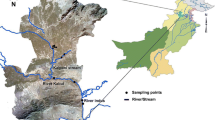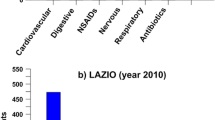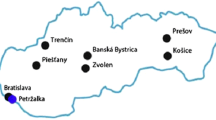Abstract
Background, aim and scope
Each year, large quantities of pharmaceuticals are consumed worldwide for the treatment and prevention of human and animal diseases. Although the drugs and the metabolites observed in the wastewaters and in the environment are present at concentrations several orders of magnitude lower than the concentrations required to exert their effects in humans or animals, their long-term impact on the environment is commonly not known. In this study, the occurrence of six antihistamines, which are used for the relief of allergic reactions such as hay fever, was determined in sewage treatment plants wastewaters and in recipient river waters.
Materials and methods
The occurrence of the antihistamines cetirizine, acrivastine, fexofenadine, loratadine, desloratadine and ebastine in sewage treatment plants wastewaters and in recipient river waters was studied. The analytical procedure consisted of solid-phase extraction of the water samples followed by liquid chromatography separation and detection by a triple-quadrupole mass spectrometer in the multiple reaction mode.
Results
Cetirizine, acrivastine and fexofenadine were detected in both influent and effluent wastewater samples at concentration levels ranging from about 80 to 220 ng/L, while loratadine, desloratadine and ebastine could not be detected in any samples. During sewage treatment, the concentration of the antihistamines dropped by an average of 16–36%. Furthermore, elevated concentrations of antihistamines were observed in samples collected during the season of most intensive plant pollen production, i.e. in May. In the river water samples, the relative pattern of occurrence of cetirizine, acrivastine and fexofenadine was similar to that in the wastewater samples; although the concentration of the compounds was substantially lower (4–11 ng/L). The highest concentrations of the studied drugs were observed near the discharging point of the sewage treatment plant.
Discussion
The highest concentrations of antihistamines in STP wastewaters correlate with the outbreak of allergic reaction caused by high amounts of plant pollens in the air. The analysis results of the river water samples show that the antihistamines are carried far away from the effluent discharge points. They may account for a part of the mix of pharmaceuticals and of pharmaceutical metabolites that occur downstream of STPs.
Conclusions
Antihistamines are poorly degraded/eliminated under the biological treatment processes applied in the wastewater treatment plants and, consequently, they are continuously being discharged along with other drugs to the aquatic environment.
Recommendations and perspectives
As a huge quantity and variety of drugs and their metabolites are continuously discharged to rivers and the sea, the compounds should be considered as contaminants that may possess risks to the aquatic ecosystem. Further studies are urgently needed on the environmental fate of the antihistamines and other pharmaceuticals in the aquatic environment. These studies should be concerned with the stability of the compounds, their transformation reactions and the identity of the transformation products, the distribution of drugs and their uptake and effects in organisms. On the basis of these studies, the possible environmental hazards of pharmaceuticals may be assessed.





Similar content being viewed by others
References
Buser H, Poiger T, Mueller MD (1999) Occurrence and environmental behaviour of the chiral pharmaceutical drug ibuprofen in surface waters and in wastewater. Environ Sci Technol 33:2529–2535
Directive 2001/83/EC of the European Parliament and of the Council, November 2001 on the Community code relating to medicinal products for human use. Official Journal of the EC L 311:67–128
EMEA (1995–2008) Scientific Guidelines for Human Medicinal Products, CPMP/ICH/381/95-ICH Q2 (R1): www.emea.europa.eu/htms/human/humanguidelines/quality.htm
EMEA (2004) Scientific discussion for the approval of Neoclarityn: www.emea.europa.eu/humandocs/pdfs/epar/neoclarityn/259700en6.pdf
Finnish National Agency for Medicines (2006), Finnish statistics of Medicines: www.nam.fi/laaketieto/kulutustiedot
Halling-Sørensen B, Nors Nielsen S, Lanzky PF, Ingerslev F, Holten Lutzhoft HC, Jorgensen SE (1997) Occurrence, fate and effects of pharmaceutical substances in the environment. Chemosphere 36:357–393
Hernando MD, Petrovic M, Fernandez-Alba AR, Barcelo D (2004) Analysis by liquid chromatography-electrospray ionization tandem mass spectrometry and acute toxicity evaluation for β-blockers and lipid-regulating agents in wastewater samples. J Chromatog A 1046:133–140
Jones OAH, Voulvoulis N, Lester JN (2004) Potential ecological and human health risks associated with the presence of pharmaceutically active compounds in the aquatic environment. Crit Rev Toxicol 34(4):335–350
Kidd AK, Blanchfield PJ, Mills KH, Palace VP, Evans RE, Lazorrchak JM, Flick RW (2007) Collapse of a fish population after exposure to a synthetic estrogen. PNAS 104:8897–8901
Lindqvist N, Tuhkanen T, Kronberg L (2005) Occurrence of acidic pharmaceuticals in raw and treated sewages and in receiving waters. Water Res 39:2219–2228
Oaks JL, Gilbert M, Virani MZ, Watson RT, Meteyer CU, Rideout BA, Shivaprasad HL, Ahmed S, Chaudry MJ, Arshad M, Mahmood S, Ali Khan AAA (2004) Diclofenac residues as a cause of population decline of white-backed vultures in Pakistan. Nature 427:630–635
Oetken M, Nentwig G, Löffler D, Ternes T, Oehlmann J (2005) Effects of pharmaceuticals on aquatic invertebrates. Part I. The antileptic drug carbamazepine. Arch Environ Contam Toxicol 49:353–361
Parfitt K. (1999) Martindale: Pharmaceutical Press, London
Product monograph for Zyrtec (cetirizine) (2006) www.pfizer.com/files/products/uspi_zyrtec.pdf
Ternes TA (1998) Occurrence of drugs in German sewage treatment plants and rivers. Water Res 32(11):3245–3260
Vieno L, Tuhkanen T, Kronberg L (2005) Seasonal variation in the occurrence of pharmaceuticals in effluents from a sewage treatment plant and in the recipient water. Environ Sci Technol 39:8220–8226
Vieno L, Tuhkanen T, Kronberg L (2007) Occurrence of pharmaceuticals in river water and their elimination in a pilot-scale drinking water treatment plant. Environ Sci Technol 41:5077–5084
**a K, Bhandari A, Das K, Pillar GJ (2005) Occurrence and fate of pharmaceuticals and personal care products (PPCPs) in biosolids. Environ Qual 34:91–104
Yamaguchi T, HashizumeT MM, Sakashita M, Fujii T, Sekine Y, Nakashima M, Uematsu T (1994) Pharmacokinetics of the H1-receptor antagonist ebastine and its active metabolite carebastine in healthy subjects. Arzneimittelforschung. 44:59–64
Acknowledgements
The authors wish to thank Maa- ja Vesitekniikan Tuki Ry. for financial support. Also the kind co-operation with the wastewater sampling staffs of the sewage treatment plant of the city of Turku, Pirjo-Riitta Mäkelä and Mauritz Sabelli are acknowledged.
Author information
Authors and Affiliations
Corresponding author
Additional information
Responsible editor: Christian Steinberg
Rights and permissions
About this article
Cite this article
Kosonen, J., Kronberg, L. The occurrence of antihistamines in sewage waters and in recipient rivers. Environ Sci Pollut Res 16, 555–564 (2009). https://doi.org/10.1007/s11356-009-0144-2
Received:
Accepted:
Published:
Issue Date:
DOI: https://doi.org/10.1007/s11356-009-0144-2




